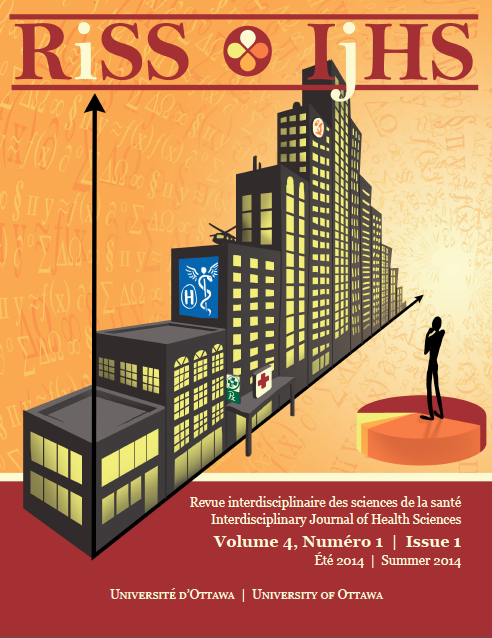Parental and Peer Influences on Adolescent Smoking: A Literature Review
DOI:
https://doi.org/10.18192/riss-ijhs.v4i1.1218Keywords:
Adolescence, smoking, peer influence, peer selection, parental influenceAbstract
Smoking cigarettes has been widely accepted as a negative health behaviour associated with many serious risks. Adolescent smoking is of particular interest from a public health perspective as the initiation of smoking in adolescence has been associated with higher addiction rates in adulthood. This review of the literature will examine the influence of social support networks, particularly parents and peers, on the initiation and escalation of adolescent smoking. The influence of social support networks primarily operates through the social learning theory, in which the adolescent mimics the behaviour of those in their social network. The literature suggests that while parents are more influential in young adolescence, peers become the main source of influence in later adolescence through processes known as peer selection and peer influence. Parents can positively affect adolescents’ smoking behaviour through effective communication and maintenance of a healthy parent-child relationship. Peers can also positively influence smoking behaviour through the same mechanisms of peer influence and selection. Knowledge of how parents and peers influence adolescent smoking initiation and escalation can potentially assist in developing public health programming that targets this high-risk behaviour.
References
Bandura, A. (Writer), & Davidson Films Inc. (Producer). (2003). Bandura’s social cognitive theory: An introduction [Video File]. Retrieved from http://ediv.alexanderstreet.com.proxy.bib.uottawa.ca/View/1641092
Barnes, G., Hoffman, J., Welte, J., Farrell, M., & Dintcheff, B. (2007). Adolescents’ time use: Effects on substance use, delinquency and sexual activity. Journal of Youth and Adolescence, 36(5), 697-710. doi: 10.1007/s10964-006-9075-0
Brady, S. S., Morrell, H. E. R., Song, A. V., & Halpern-Felsher, B. L. (2013). Longitudinal study of adolescents’ attempts to promote and deter friends’ smoking behavior. Journal of Adolescent Health, 53(6), 772-777. doi: 10.1016/j.jadohealth.2013.06.022
Bricker, J. B., Peterson, A. V., Jr., Leroux, B. G., Andersen, M. R., Rajan, K. B., & Sarason, I. G. (2006). Prospective prediction of children’s smoking transitions: Role of parents’ and older siblings’ smoking. Addiction, 101(1), 128-136. doi: 10.1111/j.1360-0443.2005.01297.x
Cole, A. G., Leatherdale, S. T., & Burkhalter, R. (2013). An examination of different smoking patterns among Canadian youth: New insight for tobacco control programming. Addictive Behaviors, 38(3), 1610-1615. doi: 10.1016/j.addbeh.2012.10.004
Ennett, S. T., & Bauman, K. E. (1994). The contribution of influence and selection to adolescent peer group homogeneity: The case of adolescent cigarette smoking. Journal of Personality and Social Psychology, 67(4), 653-663. doi: 10.1037/0022-3514.67.4.653
Griffin, K. W., Botvin, G. J., Doyle, M. M., Diaz, T., & Epstein, J. A. (1999). A six-year follow-up study of determinants of heavy cigarette smoking among high-school seniors. Journal of Behavioral Medicine, 22(3), 271-284.
Hall, J. A., & Valente, T. W. (2007). Adolescent smoking networks: The effects of influence and selection on future smoking. Addictive Behaviors, 32(12), 3054-3059. doi: 10.1016/j.addbeh.2007.04.008
Harakeh, Z., & Vollebergh, W. A. M. (2012). The impact of active and passive peer influence on young adult smoking: An experimental study. Drug and Alcohol Dependence, 121(3), 220-223. doi: 10.1016/j.drugalcdep.2011.08.029
Hoffman, B. R., Monge, P. R., Chou, C. P., & Valente, T. W. (2007). Perceived peer influence and peer selection on adolescent smoking. Addictive Behaviors, 32(8), 1546-1554. doi: 10.1016/j.addbeh.2006.11.016
Janz, T. (2012, June). Health at a glance: Current smoking trends. Retrieved from http://www.statcan.gc.ca/pub/82-624-x/2012001/article/11676-eng.htm
Maxwell, K. A. (2002). Friends: The role of peer influence across adolescent risk behaviors. Journal of Youth and Adolescence, 31(4), 267-277.
Metzger, A., Wakschlag, L. S., Anderson, R., Darfler, A., Price, J., Flores, Z., & Mermelstein, R. (2013). Information management strategies within conversations about cigarette smoking: Parenting correlates and longitudinal associations with teen smoking. Developmental Psychology, 49 (8), 1565-1578. doi: 10.1037/a0030720
Miller, T. Q., & Volk, R. J. (2002). Family relationships and adolescent cigarette smoking: Results from a national longitudinal survey. Journal of Drug Issues, 32(3), 945-972.
Peterson, A. V., Leroux, B. G., Bricker, J., Kealey, K. A., Marek, P. M., Sarason, I. G., & Andersen, M. R. (2006). Nine-year prediction of adolescent smoking by number of smoking parents. Addictive Behaviors, 31(5), 788-801. doi:10.1016/j.addbeh.2005.06.003
Scal, P., Ireland, M., & Borowsky, I. W. (2003). Smoking among American adolescents: A risk and protective factor analysis. Journal of Community Health, 28(2), 79-97.
Simons-Morton, B. G. (2004). The protective effect of parental expectations against early adolescent smoking initiation. Health Education Research, 19(5), 561-569. doi: 10.1093/her/cyg071
Simons-Morton, B., Haynie, D., Crump, A., Eitel, P., & Saylor, K. (2001). Peer and parent influences on smoking and drinking among early adolescents. Health Education & Behavior, 28(1), 95-107. doi: 10.1177/109019810102800109
Urberg, K. A., Shiang-Jeou, S., & Liang, J. (1990). Peer influence in adolescent cigarette smoking. Addictive Behaviors, 15(3), 247-255. doi: 10.1016/0306-4603(90)90067-8
Vitaro, F., Wanner, B., Brendgen, M., Gosselin, C., & Gendreau, P. L. (2004). Differential contribution of parents and friends to smoking trajectories during adolescence. Addictive Behaviors, 29(4), 831-835. doi: 10.1016/j.addbeh.2004.02.018
World Health Organization. (2014). Prevalence of tobacco use. Retrieved from http://www.who.int/gho/tobacco/use/en/
Downloads
Published
Issue
Section
License
- All authors published in the IJHS will retain copyright of their article.
- Authors grant the IJHS the right of first publication of their submitted articles.
- All articles published in the IJHS are licensed under a Creative Commons Attribution License that allows others to share articles if original authors and journal of initial publication are acknowledged.
- The IJHS is published online and in print, therefore the journal is not responsible for any unauthorized misuse of published content in either electronic or print form
- The IJHS retains the serial distribution rights to all contents
- It is the responsibility of the authors and not the IJHS to ensure proper permissions for all cited work have been obtained


